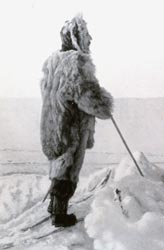|
History
Other Attempts at the Pole (1897-1900)
To avoid the obstacle of the ice pack,
a Swedish engineer named Salomon Andrée attempted to use an
unpowered helium-filled silk balloon to reach the Pole from
Spitsbergen in 1896 and 1897. Unfavorable winds cancelled the
attempt in 1896, but the following year Andrée, along with Nils
Strindberg and Knut Frankel, managed to take off. Three days
later, fog and icing caused the balloon to founder about 350
miles from Danes Island. The three men managed to reach White
Island, but it was not until over thirty years later that their
remains were discovered.
An Italian nobleman, Luigi Amedeo di Savoia, Duke of the Abruzzi,
led another attempt from the northeasternmost extremity of Franz
Josef Land, Rudolf Island in 1899. Luigi's fingers were so badly
frostbitten during winter that he was unable to make a run at
the Pole the following spring. Instead, Umberto Cagni took a
sledge party 20 miles further north than Nansen's record, but
three men perished on the return.
References:
Berton, P., The Arctic Grail: The Quest for the Northwest
Passage and the North Pole, 1818-1909, Viking Penguin, New
York, 672 pp., 1988.
Holland, C., ed., Farthest North: The Quest for the North
Pole, Carroll & Graf Publishers, New York, 311 pp., 1994.
 |
 |
Frontispiece portrait
of Roald Amundsen, 1872-1928. Source: The South
Pole, by Roald Amundsen, 1872-1928. P. 170, Volume
II
courtesy: NOAA
Photo Library; photographer: archival photograph by
Mr. Steve Nicklas, NOS, NGS |
|
Amundsen Conquers Northwest Passage (1903-1905)
With the ulterior motive of traversing
the Northwest Passage, Norwegian explorer Roald Amundsen organized
an expedition to measure the position of the North Magnetic
Pole. He selected a small sloop, the Gjöa, for maneuverability,
compared to the much larger British ships from previous expeditions.
Departing in 1903, he and six others spent two years making
measurements of the magnetic pole on the southeast corner of
King William Island, in a harbor they christened Gjöahavn. Immediately,
a band of Netsilik natives settled nearby, with whom Amundsen
bartered and learned the Inuit way of life and methods of surviving
the cold. Finally in August 1905, the Gjöa headed west,
became the first ship to navigate the Northwest Passage, and
demonstrated that there was no practical passage for larger
ships of this time. When the Gjöa became frozen in
for another winter by Hershel Island, Amundsen, impatient to
broadcast his news to the world, made an overland trek to Eagle,
Alaska. Returning the following year, Amundsen brought the Gjöa
triumphantly into Nome, Alaska. It would be another 34 years
before the passage was accomplished again.
References:
Amundsen, R., My Life as an Explorer, Doubleday, Doran
& Company, Garden City, New York, 292 pp., 1928.
Berton, P., The Arctic Grail: The Quest for the Northwest
Passage and the North Pole, 1818-1909, Viking Penguin, New
York, 672 pp., 1988.
Huntford, R., ed., The Amundsen Photographs, Atlantic Monthly
Press, New York, 199 pp., 1987.
On the web: Rine, L., The Life of Roald Amundsen
On the web: Roald Amundsen, Brief History
 Previous Chapter
Next Chapter Previous Chapter
Next Chapter

|



